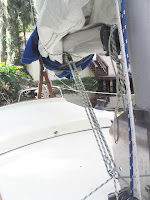Reefing Sails and a Boom Vang
A boom vang can help when the wind elevates and you need to
to
put
a reef in the sail.(check link on reefing)
You can use the vang with the
mainsheet and traveler to get a mainsail leech shape that will spill air from
the sail and this can improve the boat handling.
By tensioning the vang a little bit,
it will remove slack. Set the mainsheet on the track to where you need it and
then slack the mainsheet so that the leech (sail side away from mast) gets a
twist in it about ½ way up the sail. This will let air dump from the sail. This
will help keep the boat better balanced.
What a boom vang does is help trim
the main sail. The mainsheet line and the boom vang holds down the end of the
boom. When the boom is near the centerline of the boat or near the edge of the
boat the mainsheet can hold the boom down by itself and you can get a nice
shape to the sail with just the main sheet line, But when the boom goes out
past the boat side over the water the main sheet line cannot hold the end of
the boom down. A boom vang holds the boom down in this position and it lightens
the load you have and tension on the main sheet line. It also lets the sail shape
stay better.
When running with the wind, jibing is
more likely. A flying jibe can break equipment and take your head off. By attaching the lower end of the vang to a
solid eye pad on the deck or boat rail, the vang can ne rigged as a jibe
preventer.
A boom
break is also a great way prevent or reduce the force of a jibe.


